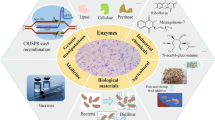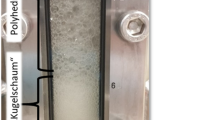Abstract
In this work, we compared the SOS response induced by vacuum-drying, desiccation (wind-spray-drying) and low-energy ion beam mock-irradiation with that of mitomycin C, UV induction. The induction factor induced by vacuum-drying and low-energy ion beam mock-irradiation was relatively higher than that of desiccation in Sa194 and JC19008 strain, respectively. These findings revealed that the SOS response produced by low-energy ion beam mock-irradiation was mainly induced by the step of vacuum-drying, unlikely by the step of wind-spray-drying. The mutation frequencies of rifampicin resistance gene in AB1157 andlacI gene in W3110 increased significantly by vacuum treatment and low-energy ion beam mock-irradiation, but had no remarkable change by desiccation treatment. Meanwhile, the mutation frequency of rifampicin resistance gene in 1C400 strain was not significantly influenced by these treatments. These results implied that the SOS response played an important role in the mutations induced by vacuum treatment and low-energy ion beam mock-irradiation.
Similar content being viewed by others
References
Ando Y., Fukuda E. (1974). Effects of drying on deoxyribonucleic acid. Radiat. Res., 15: 212–218.
Armengod M.E. (1982). recF-dependent recombination as a SOS function. Biochimie, 64: 629–634.
Asada S., Takano M., Shibasaki I. (1980). Mutation induced by drying ofEscherichia coli on a hydrophobic filter membrane. Appl. Environ. Microbiol., 40: 274–281.
Ashwood-Smith M.J., Grant E. (1976). Mutation induction in bacteria by freeze-drying. Cryobiology, 13: 206–213.
Bachmann B.J. (1972). Pedigrees of some mutant strains ofEscherichia coli K-12. Bacteriol. Rev., 36: 525–557.
Chen Y., Jiang B., Chen Y., Ding X., Liu X., Chen C., Guo X., Yin G. (1998). Formation of plasmid DNA strand breaks induced by low energy ion beam: indicating of nuclear stopping effects. Radiat. Environ. Biophys., 37: 101–106.
Craven P.A., Rycroft M.J. (1996). An assessment of galactic cosmic radiation quality considering heavy ion track structures within the cellular environment. Adv. Space. Res., 18: 45–49.
Davidov Y., Rozen R., Smulski D.R., Van Dyk T.K., Vollmer A.C., Elsemore D.A., LaRossa R.A., Belkin S. (2000). Improved bacterial SOS promoter: lux fusions for genotoxicity detection. Mutat. Res., 466: 97–107.
Defais M.P., Fauquet M.R., Errera M. (1971). Ultraviolet reactivation and ultraviolet mutagenesis of lambda in different genetic systems. Virology, 43: 495–503.
Grompone G., Ehrlich S.D., Michel B. (2003). Replication restart in gyrBEscherichia coli mutants. Mol. Microbiol., 48: 845–854.
Halliday J.A., Glickman B.W. (1991). Mechanisms of spontaneous mutation in DNA repair-proficientEscherichia coli. Mutat. Res., 250: 55–71.
Hellweg C.E., Arenz A., Meier M.M., Aumstark-Khan C. (2005). Cellular monitoring systems for the assessment of space environmental factors. Adv. Space Res., 36: 1673–1679.
Horneck G. (1999). Impact of microgravity on radiobiological processes and efficiency of DNA repair. Mutat. Res., 430: 221–228.
Jakob B., Taucher-Scholz G. (2006). Interaction of heavy ions with nuclear chromatin: Spatiotemporal investigations of biological responses in a cellular environment. Nucl. Instr. Meth. B, 245: 292–297.
Keller K.L., Overbeck-Carrick T.L., Beck D.J. (2001). Survival and induction of SOS inEscherichia coli treated with cisplatin, UV-irradiation, or mitomycin C are dependent on the function of theRecBC andRecFOR pathways of homologous recombination. Mutat. Res., 486: 21–29.
Kim I.G., Oh T.J. (2000). SOS induction of therecA gene by UV-, Y-irradiation and mitomycin C is mediated by polyamines inEscherichia coli K-12. Toxicology Lett., 116: 143–149.
Liu X.L., Cai K.Z., Feng H.Y., Yuan H., Kong M.G., Wu L.J., Wu Y.J., Yu Z.L. (2007). Effects induced by keV low-energy ion irradiationin the nematodeCaenorhabditis elegans. Radiat. Environ. Biophys., 46: 255–261.
Mancinelli R.I., White M.R., Rothschild L.J. (1998). Biopan-survival I: exposure of theOsmophiles synchococcus sp. (NAGELI) andHaloarcula sp. to the space environment. Adv. Space Res., 223: 27–334.
Melissa A.C., Marinus M.G. (2005). Differential effects of cisplatin and MNNG on DNA mutants ofEscherichia coli. Mutat. Res., 578: 406–416.
Miller J.H. (1972). Experiments in Molecular Genetics. Cold Spring Harbor Laboratory Press, Cold Spring Harbor, New York, pp. 352–355.
Morgan C.A., Herman N., White P.A., Vesey G. (2006). Preservation of micro-organisms by drying. J. Microbiol. Methods, 66: 183–193.
Murata-Kamiya N., Kamiya H., Iwamoto N., Kasai H. (1995). Formation of a mutagen, glyoxal from DNA treated with oxygen free radicals. Carcinogenesis, 16: 2251–2253.
Murata-Kamiya N., Kamiya H., Kaji H., Kasai H. (1997). Mutational specificity of glyoxal, a product of DNA oxidation, in thelacI gene of wild typeEscherichia coli W3110. Mutat. Res., 377: 255–262.
Ohnishi T.Y., Tanaka M., Yoh Y.T., Miwatani T. (1977). Deoxyribonucleic acid strand breaks during freeze-drying and their repair inEscherichia coli. J. Bacterid., 130: 1393–1396.
Phanchaisri B., Yu L.D., Anuntalabhochai S., Chandej R., Apavatjrut P., Vilaithong T., Brown I.G. (2002). Characteristics of heavy ion beam-bombarded bacteria induced direct DNA transfer. Surf. Coat. Technol., 158–159: 624–629.
Rabbow E., Rettberg P., Baumstark-Khan C., Homeck G. (2003). The SOS-LUX-LAC-FLUORO-Toxicity-text on the International Space Station (ISS).
Adv. Space Res., 31: 1513–1524.
Sedwick W.D., Brown O.E., Glickman B.W. (1986). Deoxyuridine misincorporation causes site-specific mutational lesions in thelacI gene ofEscherichia coli. Mutat. Res., 162: 7–12.
Tanaka Y., Yoh M., Takeda Y., Miwatani T. (1979). Induction of mutation inEscherichia coli by freeze-drying. Appl. Environ. Microbiol., 37: 369–372.
Tang M.L., Wang S.C., Wang T., Zhao S.G., Wu Y.J., Wu L.J., Yu Z.L. (2006). Mutational spectrum of thelacI gene inEscherichia coli K12 induced by low-energy ion beam. Mutat. Res., 602: 163–169.
Vilaithong T., Yu L.D., Alisi C., Phanchaisri B., Apavatjrut P., Anuntalabhochai S. (2000). A study of low-energy ion beam effects on outer plant cell structure for exogenous macromolecule transferring. Surf. Coat. Technol., 128–129: 133–138.
Wang Y.C., Yu R.C., Chou C.C. (2004). Viability of lactic acid bacteria and bifidobacteria in fermented soymilk after drying, subsequent rehydration and storage. Int. J. Food. Microbiol., 93: 209–217.
Wu L.F., Yu Z.L. (2001). Radiobiological efects of low-energy ion beam on wheat. Radiat. Environ. Biophys., 40: 53–57.
Yu Z.L., Deng J.G. (1991). Mutation breeding by ion implantation. Nucl. Instr. Meth. B, 59: 705–708.
Yu Z.L. (original author), Yu L.D., Vilaithong T., Brown I. (translators for the English edition) (2006). Introduction to Ion Beam Biotechnology, Springer Science & Business Media, New York.
Yukie M.S., Takashi I., Junji S., Yukie M., Sugio K., Yasuhiko K. (2000). Survival rate of microbes after freeze-drying and long-term storage. Cryobiology, 41: 251–255.
Author information
Authors and Affiliations
Corresponding author
Rights and permissions
About this article
Cite this article
Tang, M., Zhang, P., Zxu, D. et al. SOS induction by vacuum, desiccation and low-energy ion beam mock-irradiation in bacteria. Ann. Microbiol. 59, 815–821 (2009). https://doi.org/10.1007/BF03179228
Received:
Accepted:
Issue Date:
DOI: https://doi.org/10.1007/BF03179228




